
Hurricane Rita 2005
Click pictures to enlarge
Lessons Learned:
Fuel
During the Rita "bug out/evacuation" I had one gas can stolen while using the "restroom" out in the woods and another cheap department store gas can leaked gas all over my tent, fishing equipment, and ice chest.
I replaced the cheap gas cans with a couple of quality military plastic Jerry cans.
I found them at Generator Joes for $45 and Brigade Quartermaster for $42. I got mine from Brigade Quartermaster.
With the unleaded spout ($19.95 from Generator Joe and $20.99 from Brigade Quartermaster) I can empty 5 gallons of fuel into my vehicle in under 2 minutes. Below are pictures of the mounts I'm using. The cans are chained to the mounts.
Someone can still steal gas by siphoning, but that will take a while. Gas stations were places to avoid if possible. Not just because of the long waits, but also because of the flaring tempers. There was diesel avaiable, but a lot of stations closed when they ran out of gasoline even though they still had plenty of diesel and snacks.
I now have 60 gallons of fuel stored. I can use it to fuel up my car and truck, or for my generator if I decide to stay and ride out a smaller hurricane.
If you decide to store fuel, make sure you add a stabilizer like Pri-G or Stabil.
Note: Also read this note about potential fuel storage problems due to Katrina and Rita.
If you own a diesel, plan on carrying enough fuel. My next truck will probably be a diesel so I can use a transfer tank. I'd love having an extra 95 gallons of fuel along for the ride.
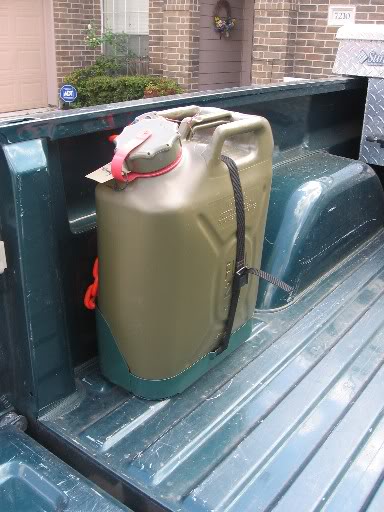
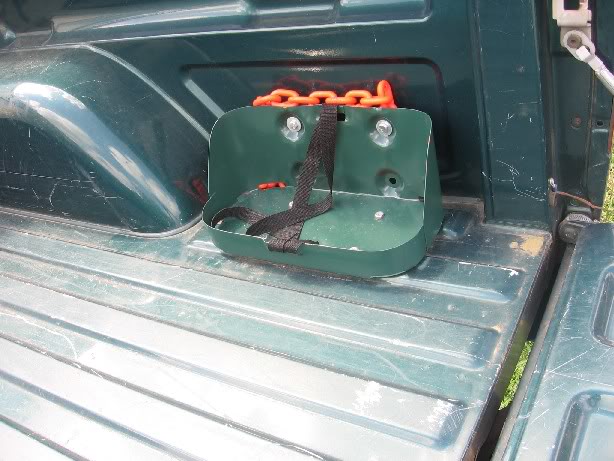
Vehicles
Sitting for 17 hours in stop and go traffic took a toll on one of our vehicles. I'm glad we had 2 vehicles or else we could have ended up on foot. Next time I think we will take 2 vehicles again, although I might use a tow dolly for one. Another reason for having 2 vehicles is I will need to return home long before my wife will. This way she won't be left without transporation. That will save fuel and let us stay together. We'll also have all the fuel in the towed vehicle. It would be nice to have 35 gallons of spare fuel for my truck.
The temperature was around 100 degrees during our bug out. My truck stayed a lot cooler due to the dark window tint than my wife's car without any tint. I was able to not run my A/C and stay much cooler than she could. Somewhere along the way we traded vehicles when hers started having problems. After driving my truck she told me she wants tint for her car. I still need to do that.
If anything is "marginal" on your vehicle, replace it now. I knew my wife's car was going to need brakes soon, but was waiting for them to wear "a little more." Well they wore a LOT driving in stop and go 1MPH traffic for over 100 miles. We ended up replacing brake pads, rotors, calipers, and a power steering rack on her car in Austin. I also changed the oil and transmission fluid in my truck while in Austin.
Vehicle Communications
The extra 2 million cell phones travelling through the Texas Hill Country made making and receiving calls almost impossible. I had anticipated this because the same thing happens when 11,000 bicyclists ride through during the MS-150. A lot of people were using FRS to communicate between vehicles on our route. Half of them on channel 1.
While the FRS channels were not totally congested, it reminded me of CB etiquette. Not something that is family friendly.
I had Ham equipment in both vehicles. Not only could we talk vehicle to vehicle without having to hear other travellers, but I had the capability of talking all over the world from my truck using HF.
I was able to find out road conditions in Austin from 100 miles away and was able to avoid a lot of traffic. Now is a good time to get your license. See ARRL for information about becoming a Ham.
APRS
Another advantage to being a Ham is APRS. This allowed me to know where the other vehicle was at all times. We never got separated, but if we had my onboard APRS mapping system would have told me exactly where the other car was. This of course depends upon a working GPS receiver. The APRS systems in both vehicles worked flawlessly.
Food & Water
Water and non-perishable food became pretty scarce just before people started evacuating. Get these way ahead of time! During our bug out in 100 degree weather we drank a TON of bottled water. 1 gallon of water per person in 100 degree weather with no air conditioning (no AC due to fuel shortages) won't cut it.
Buy 7 gallon Aquatainers and fill them with tap water. You can find them at Wal-Mart for $8.67. Don't stack them on top of each other when they're full.
The bottled water isle at Wal-Mart was completely empty 3 days before landfall. Get your water ahead of time! It will store for at least 2 years (or indefinately when stored correctly) why wait until 3 days before like so many people did? By then it is TOO late. Also, if I haven't mentioned it before. GET YOUR WATER AND FOOD AHEAD OF TIME! Another way of having water stored, without the expense of bottled water is to use old 2l soda bottles. They are not as easy to transport if you need to bug out, but do what you can afford. Owning a Katadyn water filter is also a good idea, especially if you are planning on bugging in.
Richmond Texas Wal-mart 48 hours after Rita
Where's the beef?
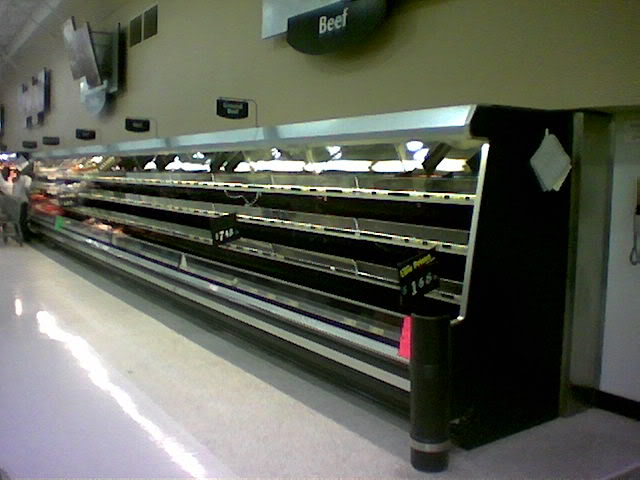
Oh, here it is:
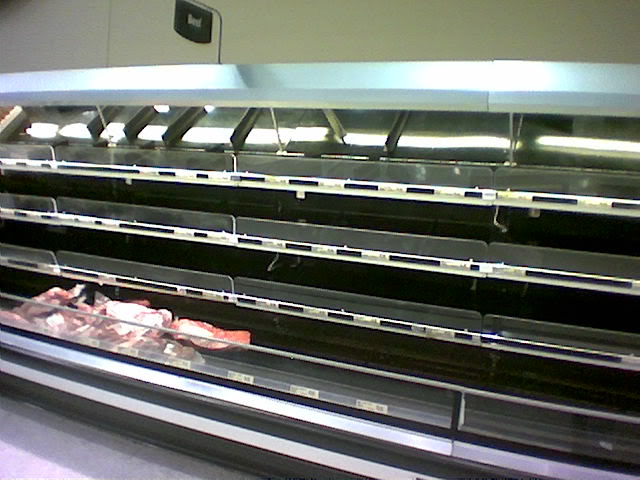
People were buying large quantities of frozen dinners on Tuesday (3 days before landfall) as that was all that could be found at Wal-mart. Some people have no idea how to prepare. There are MANY websites that tell what and how much to have for emergencies. I may not be prepared for TEOTWAWKI, but I'm not SOL if the SHTF.
We were at Wal-Mart looking for bread. There wasn't much to choose from. Funny thing though, the Rosenberg Home Depot ended up with a lot of bottled water that they didn't sell. About 2 months later they sold Nestle bottled water for $.25 per case. I bought about a four months supply of water (100 cases / 1200 liters) for my family for $25. It "expires" September 2007. There were several pickup trucks loaded down with cases of water when I picked up mine.
Wal-mart was back to "normal" within a couple of weeks, but Rita missed hitting us. It would have been worse for us if Port Lavaca, Matagorda Bay, or Freeport had taken a direct hit.
Bug Out/Evacuation Route
We took back roads towards Austin starting at 3:30am Thursday. If I hadn't been in Florida when Rita entered the Gulf I could have gotten my family out sooner. Next time I'll be in town and will get away as soon as my job will allow. Unfortunately I've learned, along with 7 million other Houston area residents, that I need to get away sooner. I need to find other routes soon. 17 hours to Round Rock is not my idea of fun. We didn't make it to our primary bug out location in Kingsland. Hopefully next time we will if we plan a little better.
Navigation
The week before I had to bug out ahead of Rita my GPS mapping system in my truck failed. (The APRS system continued to work.) I had to scramble to get maps of my route before heading out. While stopped in a long line of vehicles along Hwy 90 near Eagle Lake I had time to get my GPS mapping system working again. It was a software issue. But by the time I had the system working I was so mad at my system (self designed) that I continued using maps. When your truck is not moving for 30 minutes, you have plenty of time for map reading.
Fancy electronics need manual backups when possible!
Restrooms
Along our route most of the gas stations, convenience stores, and fast food restaurants were closed which made for no restrooms. For guys this was a minor inconvenience. There was one restroom open for ladies somewhere along the way, but there was an hour and a half wait. I got a 5 gallon HDPE bucket, similar to the Home Depot Homer bucket, and 2 lids from Wal-mart for under $6. I used a dremel to cut one of the lids the same shape as a toilet lid and using a garbage bag and some kitty litter have an instant emergency toilet. I store the garbage bags and kitty litter inside and use the non-cut lid until the bucket is needed. With a large tarp I can make a private area.
Make sure you pack an abundance of toilet paper and/or baby wipes. My wife discovered if you're without you will develop adult baby rash. Sitting for 17 hours in 100 degree weather with baby rash is fun. I recommend baby wipes as they can be used for hand washing too.
Shutters
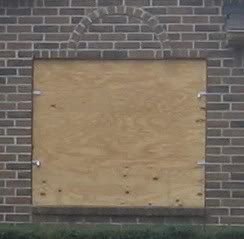
I had my plywood measurements and the cuts marked, but I didn't have my plywood cut. I figured I'd cut it when a hurricane entered the Gulf. But since I was out of state (in Orlando Florida) when that happened I had to wait until I got home Wednesday at 5:00PM. It took me 10 hours to cut the plywood, attach the barrel bolts, and drill the holes in the brick. Build your shutters beforehand! And definately make sure you buy your plywood beforehand! I had several neighbors come ask me where I bought my plywood because they couldn't find any. I had bought my plywood a couple of months beforehand and had measured all my windows. I knew exactly how much plywood I needed and didn't have any extra sheets. I had several neighbors ask for any extra I might have. I gave away a few scraps, but I didn't have much to give away. Now I can put up ALL my plywood hurricane shutters in about 30-45 minutes by myself.
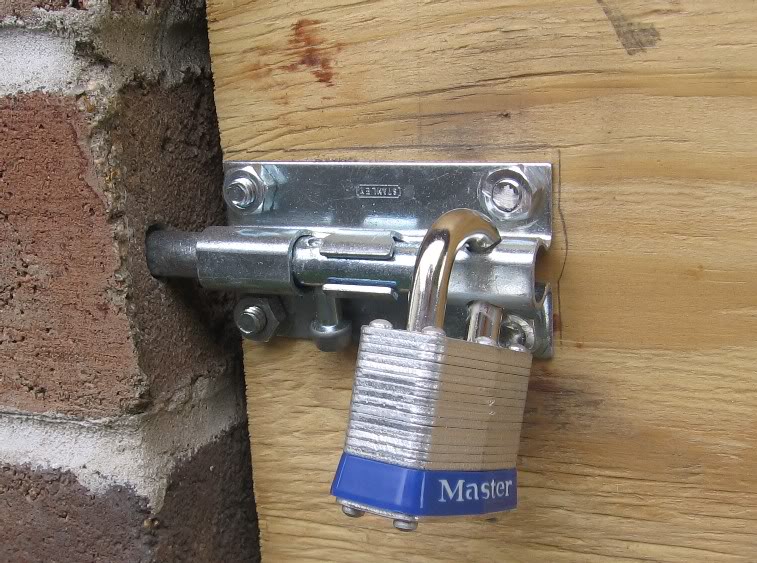
Close up of one of the barrel bolts used to attach the shutter to the window frame.
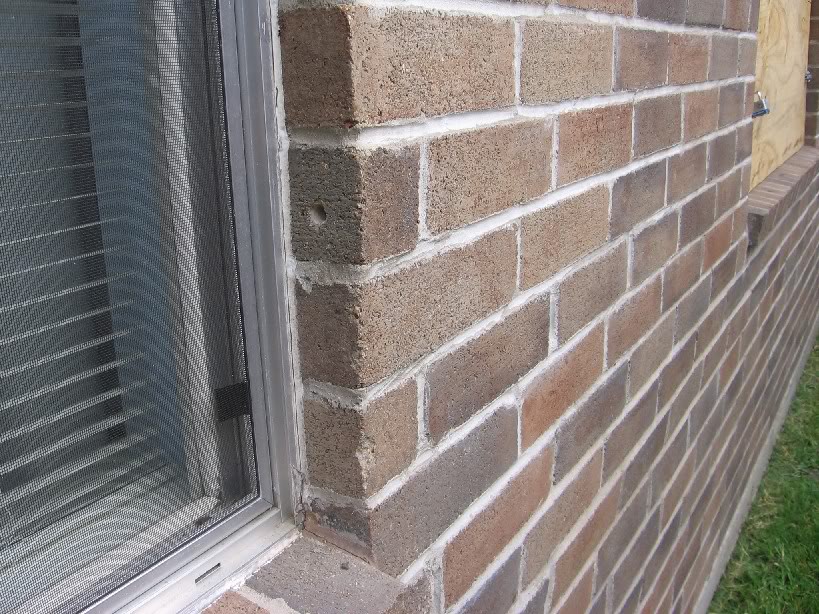
View of the window frame when the shutter is not installed. The hole is not really noticable.
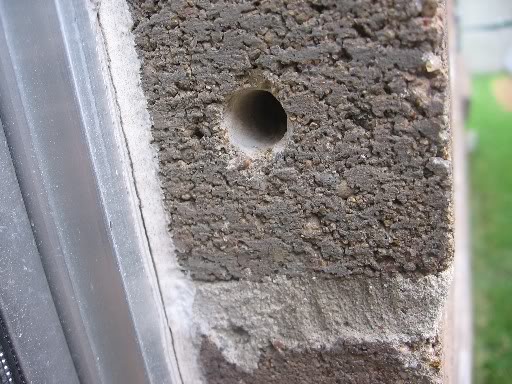
Close up of the hole for the barrel bolt.
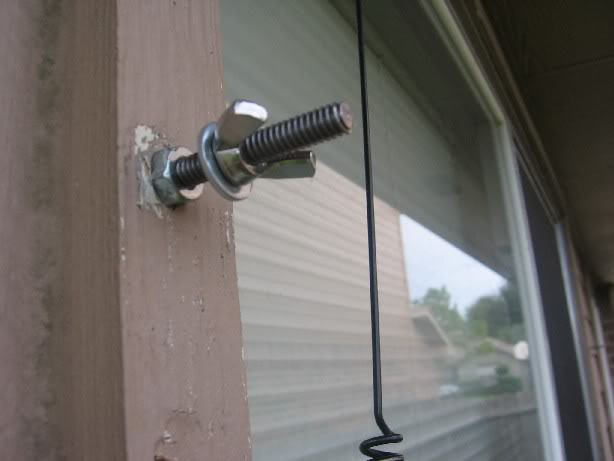
Close up of one of the shutter studs (hanger bolt) used for a window that doesn't have a brick window
frame. This window uses 2 studs mainly to hold the shutter in place. Lag bolts are used to truely fasten
the shutter to the window frame.
I have had a lot of requests for my Visio template which you can find below, along with an example .JPG. I also have heard a lot of people lately saying, "I need to go ahead and buy some plywood now for this hurricane season." We'll see how many take care of it ahead of time, and how many will again wish they had.
The company I work for has an internal swap board that several people sold their plywood after Rita. Their ads sounded like they were mad that they had wasted money on plywood and wanted to get half of their money back. Why prepare for 2006? Short sided people are annoying.
For more information about making plywood shutters ahead of time, check out:
Plywood Hurricane Shutter Instructions from NOAA
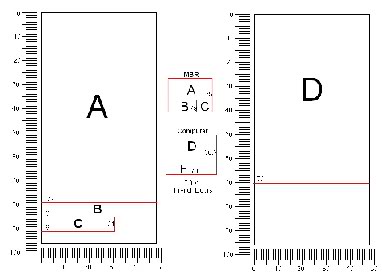
My Hurricane Shutter Visio Template. You will neeed Microsoft Visio 2000 in order to use the template.
APA Great instructions!
LOWE's Hurricane instructions.
StormSurvival
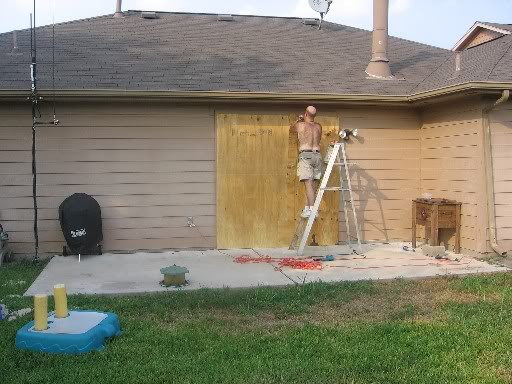
Getting ready for Rita.
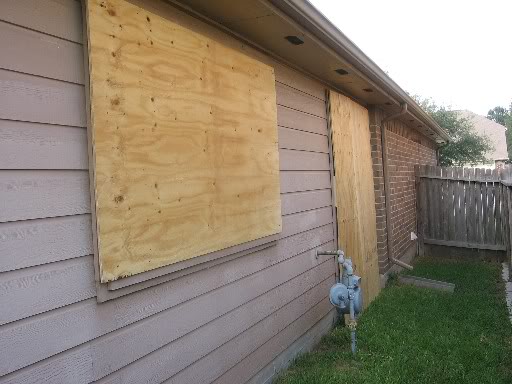
Getting ready for Rita.
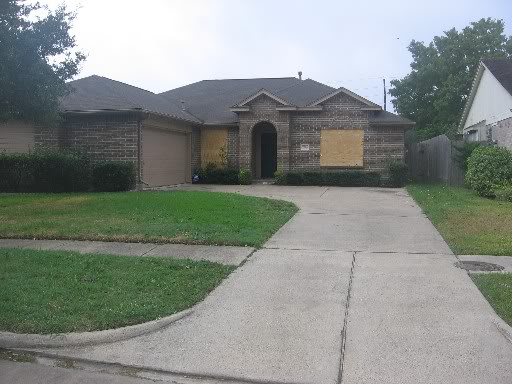
After Rita, no damage to our house.
What to expect when you get there
For those of you who didn't evacuate, but plan to next time, don't expect a welcoming committee when you arrive. I think the people of Houston did a great job of welcoming Katrina evacuees. As we rolled into Austin, we listen to non-stop call-ins on talk radio from residents of the Austin area complaining that we were a nuisance. One woman even called in to suggest that next time Houston residents should be put in train freight cars, and transported to a warehouse facility outside of Austin until we are able to return. My first thought was, "You mean a Nazi concentration camp!" (Or a FEMA camp!) The next day, as we shopped for supplies and repairs for our vehicles there was a buzz about the horrible evacuees buying up their food and gas. We quickly learned not to identify ourselves as evacuees. News reports were a mix of, weather, traffic, and lock up your daughters Austin is no longer safe!
Suggestions for when family comes knocking
If you are receiving family members into your home who have evacuated please keep these things in mind. Your loved ones are super stressed out. They have been through alot on their travels, and have many worries about their home, money, friends left behind, and much more. The last thing they want to do is to visit an expensive amusement park when they arrive. Food, sleep and weather reports were our main interests.
Why were we stressed? We didn't know what we would face when we returned as far as repairs to our home. Before we even knew the condition of our home, we had already spent over $2000 in plywood, supplies, and repairs to both vehicles in Austin so that we could return home. We just knew we were going to go broke! After all was said and done, we came out fine. We did have to continue to repair our vehicles for the next few months.
Financial: Additional thoughts from my wife:
This experience has also made us rethink our priorities. We have tried to get our financial house in order. We have made fewer silly purchases and have made more purchases that would help us be more prepared in any emergency. As we traveled slowly toward Austin, I thought about all the useless knicknacks I have bought and had visions of them washing away, or blowing away. What I value most is, God, my family, food, water, fuel and some sort of shelter. I would be sad to lose family photos. All the rest would just be money down the drain. Watching all that many Katrina victims had lost reminded me of:
Matthew 6:19-20
"Do not store up for yourselves treasures on earth, where moth and rust destroy, and where thieves break in and steal. But store up for yourselves treasures in heaven, where moth and rust do not destroy, and where thieves do not break in and steal."
We still have too much stuff!
Final Thoughts
After the many comments I've received from visitors and co-workers, I've found that everyones experience was different. If you have any suggestions or lessons you would like to share, please e-mail me!
Same Storm, Different Lessons.













